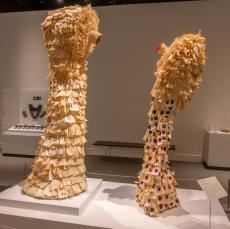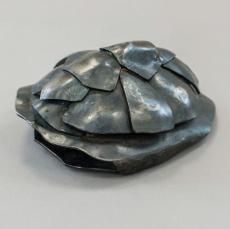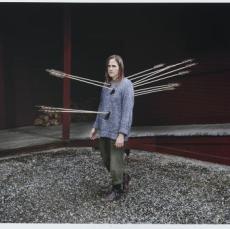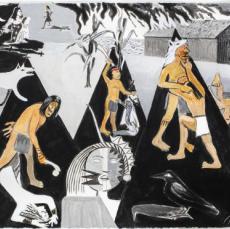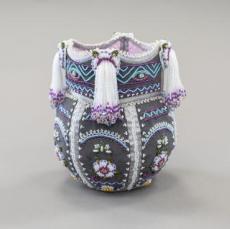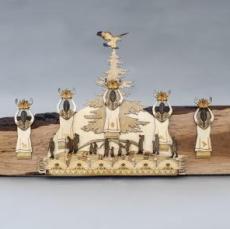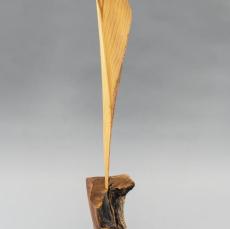Featured Past Exhibit: Each One Inspired: Indigenous Art Across the Homelands
This contemporary art exhibition featuring over 60 works from the NYSM Contemporary Indigenous Art Collection is on view at the New York State Museum until March 31, 3024. We invite you to see it in person and to explore a selection of the works below.
The State Museum began collecting contemporary Indigenous artwork in 1996 with the goal of creating an expansive and representative collection of Indigenous works by artists whose homelands lie within what is now New York.
The following artists are featured (in order of appearance in the exhibition):
Dawn Dark Mountain, Anthony Gonyea, Rose Kerstetter, Brenda Hill, Lydia Wallace-Chavez, Natasha Smoke-Santiago, Peter B. Jones, Raohserasawi Hemlock, Norman Jimerson, Carson Waterman, Samuel Thomas, Dan Hill, Luanne Redeye, Marjorie Skidders, Brandon Lazore, David Fadden, Larry Jacobs, Reva Fuhrman, Erin Lee Antonak, Tohanash Tarrant, Grant Jonathan, Bryan Printup, Rosemary Hill, Samantha Jacobs, Mary Jacobs, Carrie Hill, Rain Hill, Robin Lazore, Brooke Vandewalker, Ronni-Leigh Goeman, Stonehorse Goeman, John Fadden, Murisa Printup, Robert D’Alimonte, Noel Benson, Diane Schenandoah, Matilda Hill, Dorothy Printup Winden, Louise Henry, Sophronia Thompson, Penny Hudson, Ethyl Zomont, Angel Doxtater, Leah Shenandoah, Faye Lone, Niio Perkins, Isabella Thompson, Bruce Boots, Jeremy Dennis, G. Peter Jemison, David Martine, Jamie Jacobs, Ken D. Williams Jr., Orlando Dugi, Wilma Zumpano-Cook, Jay Havens, Ann Mitchell, Stan Hill Sr., Erwin Printup Jr., Hayden Haynes, Stan Hill Jr., and Karen Ann Hoffman, Margaret Jacobs, and Robert Griffing.
Erin Lee Antonak, OnΛyota’a:ka (Oneida Nation, NY)
Erin Lee Antonak grew up in a family of artists who sold craft and art pieces at pow wows, festival gatherings, and to museums. She became skilled at working with cornhusk, a material used by Haudenosaunee women for thousands of years, to make objects for everyday and ceremonial use. As a young adult, Erin faced a family emergency that required her to move home and take care of her mom and siblings. During that time, she found healing through creating works with cornhusk. Her artwork seeks to explore the connection between resilince, healing, and craftwork, as well as her own identity as an Oneida woman.
How do we activate our DNA to source resilience through craft? And how do we recognize our strength through craft?
New York State Museum, E-2023.5.1
Margaret Jacobs, Kanien’ kehá:ka, (Mohawk)
Margaret Jacobs, Kanien’keha, (Mohawk)
Shedding Armor, 2019
Pounded steel
NYSM E-2019.13
In my work, I am exploring the fragility and complexity of decay and growth in nature by creating organic imagery from steel, and the visual narratives in my work come from elements that are important to me personally, familiarly, and culturally. Shedding Armor speaks to the stability and adaptability of Turtle Island as well as alluding to its simultaneous need to be protected.
New York State Museum, E-2019.13
Jeremy Dennis, Shinnecock and Hassanamisco-Nipmuc
Nothing Happened Here explores the violence/non-violence of postcolonial Native American psychology. My work is a reflection of my experience and observations in my community, the Shinnecock Reservation in Southampton, New York, and specifically the burden of loss of culture through assimilation, omission of our history in school curriculum, loss of land, and economic disadvantage.
The arrows act as a symbol of everlasting indigenous presence. The decision to use non-native subjects reveals a shared burden. How do we overcome this troubled past?
New York State Museum, E-2016.44
G. Peter Jemison, Onöndowa’ga:’ (Seneca)
Ganondagan State Historic Site, where Pete Jemison was the site manager from 1985 to 2022, is located on what was once a Seneca village. In 1687, the French forces attacked the village. However, they were outsmarted by the Seneca who sent their women and children safely away and burned the remaining crops and longhouses before the French could destroy them. Jemison’s painting references Picasso’s Guernica (1937) to make a statement about the horrors of warfare.
New York State Museum, E-2018.16
Wilma M. Zumpano-Cook, Kanien’ kehá:ka (Mohawk)
This piece is inspired by Haudenosaunee pottery from the 1500s. This vessel is made of fabric panels and glass beads covering a glass vase that provides the form. The beadwork designs and techniques Zumpano-Cook uses were developed and continued to be used by Mohawk beadworkers in the 19th and 20th centuries.
New York State Museum, E-2019.15
Yaihra? tha? (Murisa Printup) and Rayekwiratkyehena:we:k (Robert D’Alimonte), Skarù:rę? (Tuscarora)
In August 2018, the Great Law Recital was hosted by the Tuscarora Nation. By all accounts, this was the first time this had been done since we made the migration up north in the early 1700s to join our brothers and sisters among the Haudenosaunee Confederacy.
During the early 1700s, as colonists were encroaching on our land, a war broke out. We lost nearly 1,000 men, women, and children. Our ancestors headed north to seek peace among the Haudenosaunee—people we lived with about 1,300 years before.
We have lived as the Sixth Nation of the Haudenosaunee Confederacy to this day.
The recital of the Great Law is an event for Haudenosaunee people. The responsibility of hosting the gathering rotates throughout the different Haudenosaunee Nations. The gathering includes leaders and knowledge keepers reciting and sharing oral histories, teachings, and philosophies in Haudenosaunee languages.
Inspired by this historic event, Yaihra? tha? and Rayekwiratkyehena:we:k collaborated to create this piece. It depicts a number of key events: the Tuscarora Migration, the Tuscarora Taken-In Belt, the Great Tree of Peace, and the seven Tuscarora Clans. The Clan Mothers, each holding a gustoweh, are shown raising up their chiefs under the Tree of Peace.
New York State Museum, E-2019.17
Diane Schenandoah, Honwadiyenawa’sek (One Who Helps Them), OnΛyota’a:ka (Oneida Nation, NY)
This sculpture honors Yothihsótha (Our Grandfathers) Latihsakayu∙téhseˀ (The Thunderers). In Haudenosaunee creation narratives, the Thunderers bring the gift of rain to the Earth and all living creatures. Their presence signals the beginning of spring.
New York State Museum, E-2019.19



